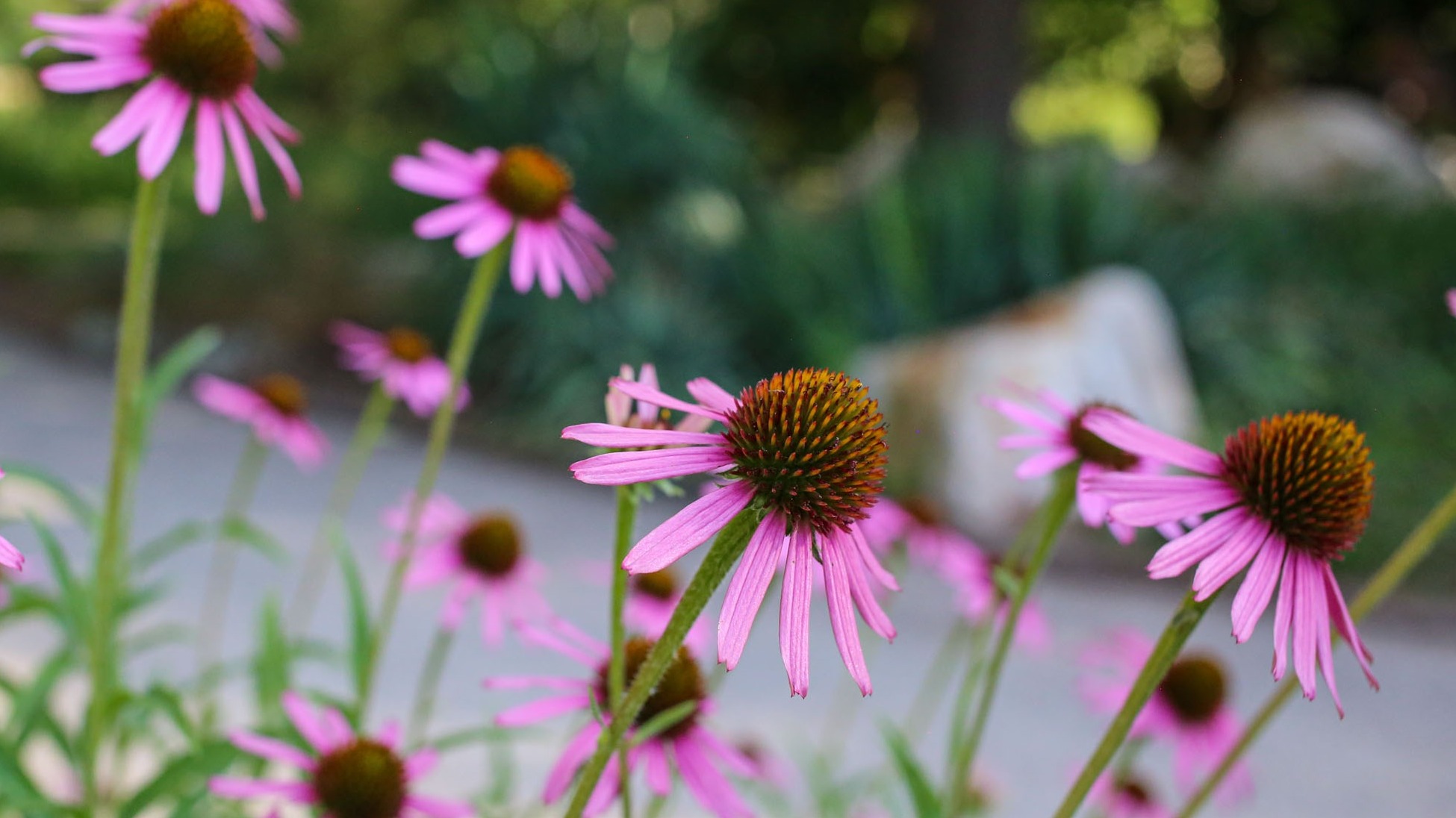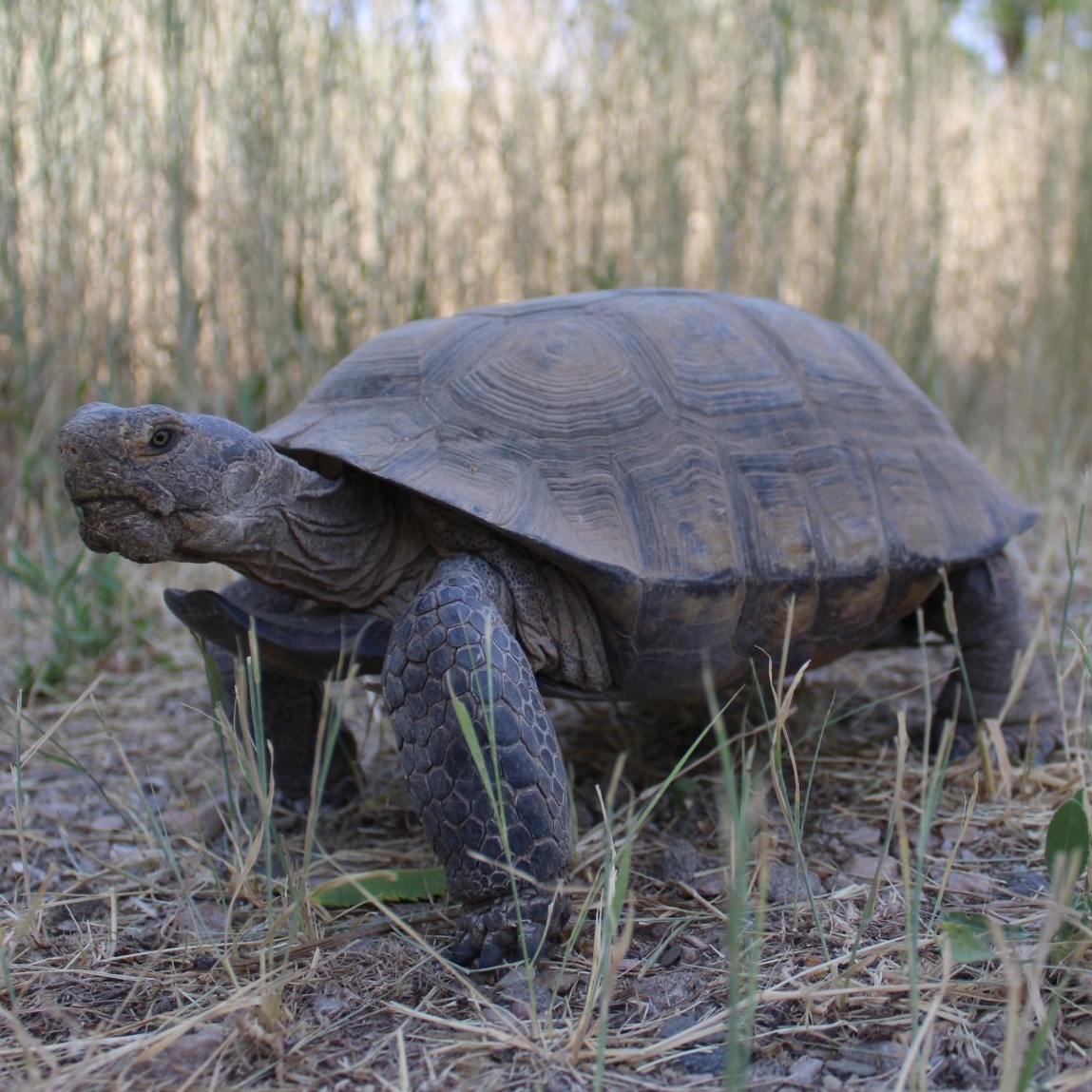Written by Sarah Kapel / Photo by Abbey Soukup
It’s been a sizzlin’ summer in Utah. This heat can be a lot for our hot-blooded bodies. However for cold-blooded critters, such as the Desert Tortoise, this is a great time to soak up some sun. Desert Tortoises (Gopherus agassizii) range north and west of the Colorado River in Arizona, southern Utah, Nevada, and southern California. They live in arid landscapes with sparse vegetation, feasting on cacti, small forbs, grasses, and wild fruit. You may be lucky to see one on your next desert adventure, or, come say hello to our two resident Desert Tortoises at the Ogden Nature Center, Rex and Lazer, during your next visit.
Dersert Tortoises have strong, round legs with sharp claws, which are adapted to walking in sand and digging burrows. Tortoises construct burrows up to 30 feet in length-in general. Because they are cold-blooded, tortoises are not able to regulate their body temperature internally. Burrowing is an adaptation that mitigates the effects of the desert’s extreme temperature and moisture extremes, and protects animals from predators.
Since water is hard to come by in the desert, tortoises have adapted to well water by digging depressions in the earth that collect rainwater. They are also able to store water in their urinary bladder and significantly increase their body weight by storing water after a good rainstorm. Mojave Desert Tortoises are a keystone species, which means they have a higher influence over their ecosystem than other species. Mojave Desert Tortoises are usually solitary, but sometimes they share burrows. They have even been documented to share burrows with other critters such as snakes and gila monsters.
Male Desert Tortoises are larger than females and can be identified by curved horns on the lower shell, beneath the neck. Once they reach adulthood, Mojave Desert Tortoises can live between 30-50 years in the wild, and sometimes up to 80 years. Unfortunately, due to habitat destruction Desert Tortoises are struggling for survival.
Listed as threatened in 1990, these tortoises are impacted by ongoing threats. The loss, degradation, and fragmentation of habitat due to development has resulted in more roadkill of Desert Tortoises. Ravens and other birds that prey on tortoise eggs are also more prevalent in urban settings, contributing to higher rates of depredation. Tortoises have also been impacted by increased wildfire due to non-native invasive vegetation such as cheatgrass.
The release of former pet tortoises into the wild has resulted in a deadly bacterial infection among wild tortoises. Upper Respiratory Tract Disease attacks the tortoise’s respiratory system and can be transmitted through sharing of burrows or through human handling of tortoises. This can occur when a person handles a sick tortoise and then unwittingly transmits the disease to a healthy animal. It is critical that infected tortoises are isolated from wild populations in rehabilitation programs.
What can you do to help desert tortoises?
- Clean off your car tires and shoes before heading into desert habitat. This can help prevent introducing nonnative grass seeds. Take care to not spark wildfires. Camp and hike responsibly.
- When in the desert, check under your car to see if any desert tortoises (or other wildlife!) have taken shelter from the sun in the car’s shade. Drive slowly and vigilantly to reduce roadkill.
- If you encounter a Desert Tortoise, DO NOT touch it or pick it up. You can spread disease unknowingly. You can also stress the tortoise which causes it to release precious water reserves. Only move Desert Tortoises if there is a present danger, such as being on a busy road.
- Limit habitat loss by supporting developments on already degraded lands, such as landfills and abandoned mining sites, rather than on undisturbed desert habitat.
- Pack out trash and pick up litter you encounter while out in the desert. Bright colors from trash can be deceiving to tortoises and they may mistake them as plants.
References:
Desert Tortoise (Gopherus agassizii) | U.S. Fish & Wildlife Service. (n.d.). Retrieved July 17, 2024, from https://www.fws.gov/species/desert-tortoise-gopherus-agassizii
Mojave Desert Tortoise. (n.d.). The Nature Conservancy. Retrieved July 17, 2024, from https://www.nature.org/en-us/get-involved/how-to-help/animals-we-protect/desert-tortoise/
Palms, M. A. 74485 N. P. D. T., & Us, C. 92277-3597 P. 760 367-5500 C. (n.d.). Desert Tortoise - Joshua Tree National Park (U.S. National Park Service). Retrieved July 17, 2024, from https://www.nps.gov/jotr/learn/nature/tortoise.html

















